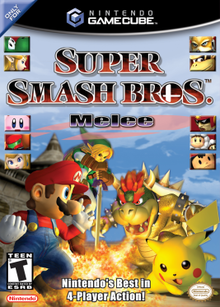| Super Smash Bros. Melee | |
|---|---|
 North American box art | |
| Developer(s) | HAL Laboratory |
| Publisher(s) | Nintendo |
| Director(s) | Masahiro Sakurai |
| Producer(s) |
|
| Designer(s) |
|
| Programmer(s) | Yoshiki Suzuki |
| Artist(s) | Hitoshi Kobayashi[1] |
| Composer(s) |
|
| Series | Super Smash Bros. |
| Platform(s) | GameCube |
| Release | |
| Genre(s) | Fighting |
| Mode(s) | Single-player, multiplayer |
Super Smash Bros. Melee[a] is a 2001 crossover fighting video game developed by HAL Laboratory and published by Nintendo for the GameCube. It is the second installment in the Super Smash Bros. series. It features characters from Nintendo video game franchises such as Mario, The Legend of Zelda, Star Fox, Pokémon, and Donkey Kong among others. The stages and gameplay modes reference or take designs from these franchises as well.
Melee includes all playable characters from the first game and also adds characters from additional franchises such as Fire Emblem, of which no games had been released outside Japan at the time, in addition to new stages and gameplay modes. Like other games in the Smash Bros. series, Melee's gameplay system offers an unorthodox approach to the fighting game genre, with a counter that measures damage with increasing percentages, representing the knockback the character will experience, rather than a depleting health bar seen in most fighting games.
Melee was first released in Japan in November 2001, in the Americas in December 2001, and in Europe and Australia in May 2002. The game received widespread acclaim from critics, earning praise for its visuals, simple controls, gameplay, and orchestrated soundtrack, as well as several awards and acknowledgments from various publications; it is now considered one of the greatest video games ever made. It achieved strong sales upon its release, becoming the GameCube's best-selling title, with over seven million copies sold by 2008. Considered one of the most competitively viable Smash Bros. games due to its fast-paced and aggressive gameplay, Melee has been featured in many competitive gaming tournaments, boasting a dedicated grassroots fan community which has kept its competitive scene alive well beyond the game's original lifespan. It was followed by Super Smash Bros. Brawl for the Wii in 2008.
- ^ "Full Game Credits". N-Sider. Archived from the original on November 7, 2007. Retrieved April 29, 2021.
Cite error: There are <ref group=lower-alpha> tags or {{efn}} templates on this page, but the references will not show without a {{reflist|group=lower-alpha}} template or {{notelist}} template (see the help page).